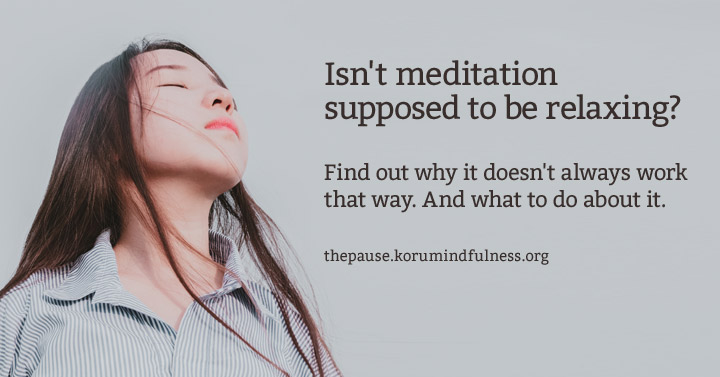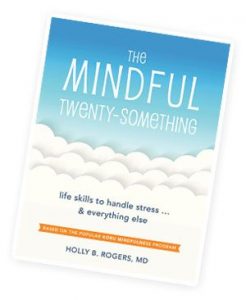
In my Koru Mindfulness class this week, several students were expressing their frustration that their meditation practice wasn’t always relaxing. Sometimes instead of feeling calm and peaceful during meditation—their ideal state—they felt restless and frustrated.
They believe that if they feel peaceful, they are doing it “right”. And if they don’t feel peaceful, they are doing it “wrong”.
My students know this of course, but even though they understand with their brilliant thinking minds that the goal of mindfulness meditation is not to feel calm and relaxed, they still really want to feel calm and relaxed.
Of course they do! We all want to feel calm and relaxed, all the time. Most people who sign up for a meditation class are not doing it because they wish to feel more stressed.
Almost always they are trying out meditation because they already have too much stress; they want to find a way to feel calm and peaceful.
I think I must be quite a disappointment to my students when I say, “Yeah, no. That’s not how it works.”
What?
If you develop a consistent meditation practice, you will almost certainly find that overall you are more calm and peaceful than before you started meditating. But it won’t be because you have figured out a way to create relaxation on command.
We’re now on Instagram and Snapchat! Make sure to connect with us for tips and inspiration!
Big Suffering and Little Suffering.
I’ve talked about Big Suffering and Little Suffering before. Let’s revisit it.
Big Suffering happens to everybody. People trying to put their lives back together after a devastating loss. People without homes. People with serious illness. People who are marginalized and oppressed. The list goes on.
Though all of us will face some Big Suffering at some point in our lives, most of us aren’t dealing with Big Suffering all the time.
It sets in when you spill your coffee or fight with your girlfriend. Or when you lose your phone or have to call the cable company. Or when you have a bad case of FOMO because you have to work or study while your friends are hanging out.
It also happens when you are meditating and you want to feel peaceful but instead you feel restless. Which is why meditation is the best way to learn to deal with Little Suffering so that you are not made miserable by it all the time.
Minding the gap
Perhaps all suffering, but especially Little Suffering, is caused by the gap between how things are in this moment and how you wish they were.
When you feel restless or anxious during meditation, much of the suffering you experience is due to wanting things to be different in the moment. So you have thoughts like:
“I feel really stressed.”
“I thought meditation was supposed to make me calm.”
“Why am I not calm.”
“Am I not doing this right?”
“This is so frustrating.”
“When is this going to be over?”
Those thoughts add to your stress and frustration, amping up the Little Suffering in the moment. Soon you feel like your head will explode if your meditation timer doesn’t go off right NOW.
Your thoughts are widening the gap between how things are (there are some unpleasant sensations in your body) and how you want them to be (only pleasant sensations in your body.)
How do you instead narrow the gap between how things are and how you wish they were?
It is simple but not easy. The trick is to be curious and interested in the uncomfortable feelings without trying to suppress them or shove them away.
You do this by shifting to observing what is happening in the moment instead of evaluating it. What is present? Tension in your body? Anxious thoughts? The desire to feel differently?
Get as curious as you can about that desire to feel differently. What does that desire feel like? Where is it located in your body? And keep breathing, watching the breath, feeling the restlessness, noticing the not-liking-it feeling with curiosity.
Welcome the restlessness instead of pushing it away. Treat it like an old friend who has come to visit. Offer this old friend a seat, and see how long he chooses to stay this time.
If you get good at doing this in meditation practice—watching with curiosity the desire for things to be different—you’ll get better at doing it in real life, and your Little Suffering will lighten up. And that is when you are likely to notice more of that peace of mind you were after in the first place.
So next time you are meditating and wishing you were more relaxed, try welcoming the feeling and get exceptionally curious about it. Let us know what happens in our comment section below. .
Photo by Thien Dang on Unsplash
Get our latest articles in your inbox.

This is a timely blog Holly! Such a succinct yet profound way to express the mechanism and benefits of cultivating an observing mind. It was a good reminder for me personally, but also informs my work here at Butte College with students. Thank you 🙂
Holly, I can just remember your soothing teachings on being curious with what is happening in the moment, as I sit here over 3,000 miles away. So nice to still get these updates every so often, I always appreciate your thoughts and wisdom. It is a strange work of art the way settling in with the intent to observe and notice, to rest awareness with what the mind is doing, be it relaxing or painful, tends to point us in the way of liberation and peace. It is almost like you have to just create enough openness to let it happen. Thoughts are big. I’m still continuing my journey of just creating enough space for them to bubble up and work themselves out, so that my true self becomes more and more visible. It is a lovely lifelong journey to be on, and I’m proud and grateful to say it started with you and the team there at Koru. I sit with my colleagues every Tues. and Thur. as an official group that my organization supports. So nice to continue to have a community to practice with. I often offer guidance to the group and set the stage for the sit each day, so it is an amazing feeling to be able to offer what I have learned to people who seem to benefit from it. I’ve also played some of your guided sits for them, so thank you for offering those online. Keep well.
Hi Jonathan. Wonderful to hear you are still deepening your mindfulness practice and sharing it with others. It is so inspiring to see how our community continues to grow and impact the world in positive ways. Thanks for sharing your experience. Take care, Holly